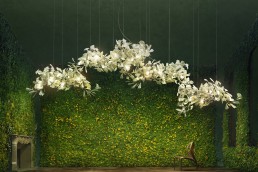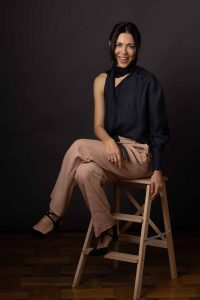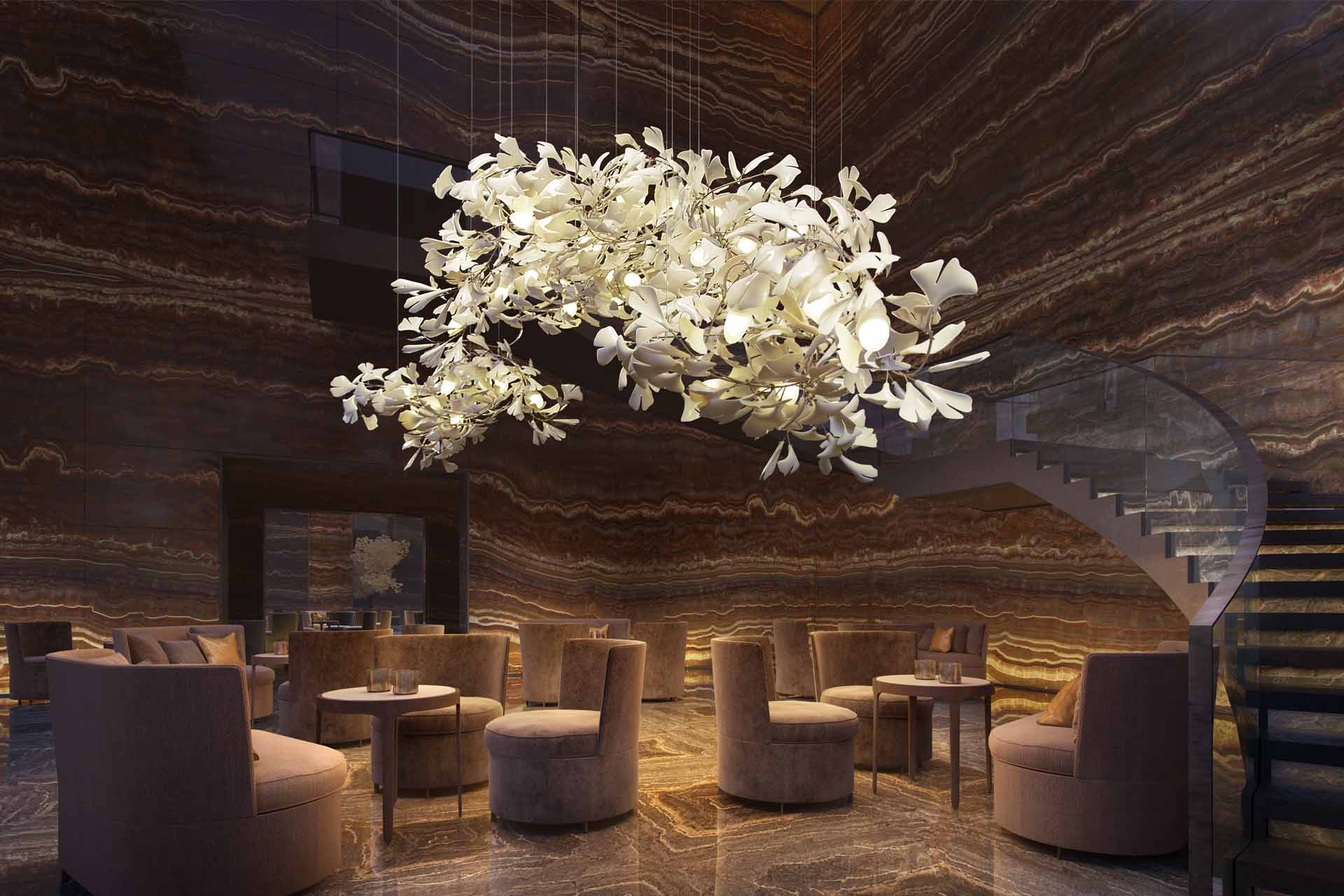
darc dialogues: Andrea Braescu
 “I know I’ve succeeded when my work evokes the joy and serenity that being in nature brings.”
“I know I’ve succeeded when my work evokes the joy and serenity that being in nature brings.”
Meet Andrea Braescu, an award-winning interior artist, whose handmade porcelain light sculpture blends emotional depth with functionality. Based in Romania, Braescu’s work channels the beauty and calmness of nature, turning interiors into peaceful sanctuaries. Braescu primarily works with fine bone china, a ceramic material valued for its translucency and durability. When lit, the delicate, handcrafted components such as petals and leaves, produce a soft, atmospheric glow. One of her notable works, Grinko, features 700 individually crafted porcelain leaves suspended in a flexible arrangement, resulting in a sculptural installation that blends organic forms with architectural structure.
In a new Q&A series called darc dialogues, Braescu shares insights into her journey, discusses her design influencers, her connection with nature, and her journey with lighting design.
When was your first interaction with lighting and what was it about that experience that led you to your career now?
I’ve always felt a pull towards light and how it shapes our mood. My first real interaction came when I was still a student. I remember seeing the translucency of porcelain for the first time, how it could hold light yet look so delicate. It was magical for me and that moment stayed with me. It made me realise I wanted to bring the serenity and spirit of nature indoors through light and form.
You’ve described your work as capturing the essence of nature – what drew you to nature as your primary source of inspiration?
Nature has always felt like the purest source of harmony. Growing up, I would spend hours just observing the veins of a leaf or the way sunlight moves through branches. Nature’s quiet perfection inspires me endlessly. My work is my way of bringing that same calm and wonder into the spaces we live in.
Is there a particular landscape, season, or natural element that consistently informs your work?
Leaves are a constant for me. They’re such a perfect example of nature’s balance between chaos and order. I’m drawn to patterns like dappled light through trees or the gentle movement of water. Spring holds a special place in my heart because it’s full of renewal and quiet energy.
How do you translate such an organic, intangible feeling into a medium like porcelain?
It always begins with observation and sketching moments that catch my eye. Then comes the hands-on part. Each porcelain leaf or petal is shaped by hand. There’s a beauty in allowing the material’s little imperfections to stay just like in nature. When light passes through the porcelain, it reveals the softness and movement, I want people to feel.

What is your biggest installation to date, or the one that left you feeling the most accomplished?
One of my most technically complex pieces is Nimbus, a cloud-like sculpture with hundreds of hand-crafted porcelain leaves for a private residence in London. Another proud milestone was my large-scale public installation in New York, which has around 155 porcelain leaves, some finished in gold. Both projects pushed me and my team to balance delicate craft with bold engineering, and seeing them come to life was incredibly fulfilling.
Could you walk us through the journey from concept to completed installation?
Every piece starts with an idea, often sparked by a shadow, a pattern of light, or a texture in nature. I sketch, then shape each porcelain element by hand. The firing process demands patience because porcelain can be so temperamental. Once everything is ready, we assemble the pieces and test how they interact with light. The final installation is about precision and making sure it appears to float naturally in the space.
Why porcelain – more specifically, why fine bone china? What does it offer that other materials don’t?
Porcelain’s translucency is like nothing else. Fine bone china lets light filter through in a way that feels alive, soft and warm. It’s also one of the most challenging materials to work with, which keeps me humble and always learning. Each leaf or petal ends up with its character, and that’s what makes it feel real.
Are there any challenges or surprises that come with working so intricately with light and porcelain?
Definitely. Porcelain has a mind of its own. Pieces can crack or change shape in the kiln even when you think you’ve done everything right. Then there’s the engineering side, making sure all the wiring and support stay hidden, so the sculpture looks like it’s grown there naturally. It’s always a balance of fragility and precision.
You’ve said your work aims to evoke “the joy and serenity of being in nature.” How do you measure whether you’ve succeeded in that goal?
I know I’ve succeeded when someone stands beneath a piece and feels a bit lighter, as if they’re part of a forest or a dream. That quiet moment means everything to me.
How much input do clients have when commissioning a bespoke piece?
Every commission is a conversation. I listen carefully to what a client wants to feel in their space, but I always stay true to the organic nature of my work. It’s about finding the right balance, so the piece feels alive and at home.
Are there any dream spaces – museums, public areas, or buildings – that you would love to create an installation for?
A boutique hotel in Paris, especially in a restored 19th-century building, is a dream of mine. I’d also love to create larger pieces for botanical gardens or museums, places where people already go to feel inspired and connected with nature.
You mention pushing the boundaries of material and technology. Can you share any recent explorations in that area?
My team and I are always refining how we combine modern engineering with the handmade spirit of the work. Lately, we’ve been experimenting with lighting that shifts with the time of day or mood. But it’s important that the technology never overshadows the organic soul of each piece.
What does a typical day in your studio look like?
My studio is my sanctuary. A day might start with sketching or testing new forms. I spend hours shaping porcelain leaves and petals by hand alongside my team of designers and engineers. Some days are all creative flow, others are about solving practical problems. I love that balance.
How do you stay creatively energised in your work and avoid repetition?
Nature never repeats itself, so I try not to either. When my ideas feel too predictable, I go back to observing. A simple walk outside can completely reset my mind. I also welcome mistakes; they often lead me in new directions.
If you weren’t working in lighting, where else do you think you’d be?
I’d still be working with my hands, probably sculpting on a larger scale or creating land art that interacts with nature. Whatever it would be, it would have to honour the same sense of wonder I find in light and porcelain.
What’s next for you creatively? Any upcoming projects or shifts in direction?
I’m working on a new series inspired by how water moves and how light plays through it. I’m also dreaming of larger outdoor installations that feel like you’re stepping into a living sculpture. There’s still so much to explore with porcelain, light and nature. I feel like I’m only at the beginning.


